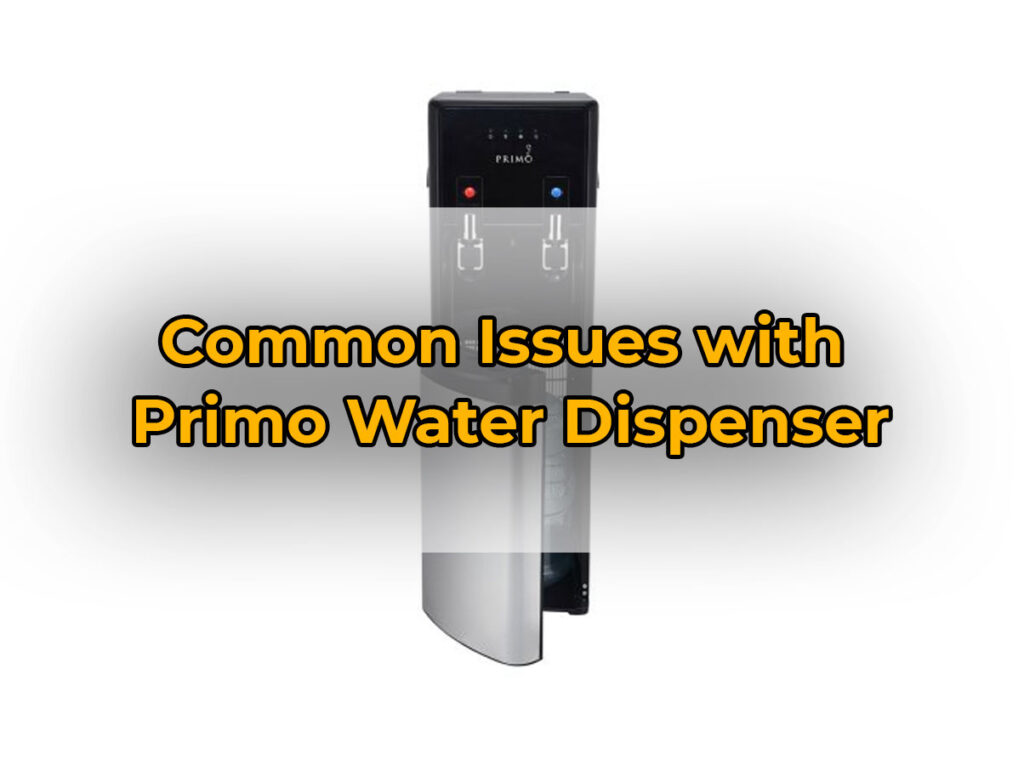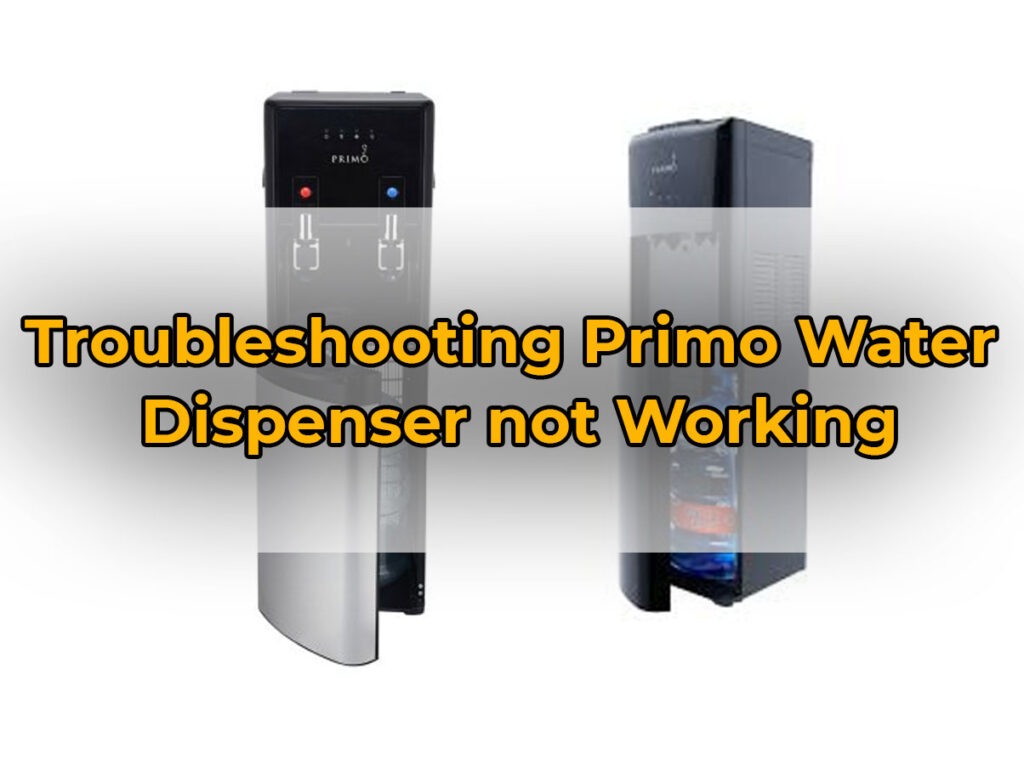Wondering why Primo water dispenser not working? Many users have encountered issues ranging from the dispenser not dispensing water at all to problems with the cooling or heating functions.
However, before you panic and consider purchasing a new unit, there are several troubleshooting tips you can try to get your Primo water dispenser back up and running.
Here is detailed explanation on Primo water dispenser not working!
Common Issues with Primo Water Dispenser

Wondering Primo water dispenser not working? If you’re having trouble with your Primo water dispenser, here are some common issues you might encounter:
1. Dispenser not turning on
Firstly, check if the power cord is properly plugged into an electrical outlet if Primo water dispenser not working. Sometimes, due to accidental tugs or movement of the dispenser, the plug may become loose and lose connection.
Make sure it is securely inserted into a functioning socket and try turning on the dispenser again. Additionally, inspect the power switch located at the back or side of the machine; ensure it’s in the ON position. Check also: Can Water Heater Explode if Turned Off?
2. Water not flowing properly
A clogged or dirty filter could be the culprit behind the restricted flow of water. Over time, mineral deposits and impurities can accumulate in the filter, hindering its ability to purify the water effectively.
To resolve this issue, check your owner’s manual for instructions on how to replace or clean the filter. Regular maintenance will ensure optimal performance and prevent any blockages that may disrupt the flow.
3. Water not getting cold/hot
One main cause of your Primo water dispenser not working and delivering cold or hot water is an inadequate power supply. If the dispenser is not properly plugged in or if there is a problem with the electrical outlet, it may not be receiving enough power to cool or heat the water effectively. Ensure that the dispenser is securely plugged into a working outlet and check for any loose connections or frayed wires.
Another potential culprit could be a malfunctioning thermostat. The thermostat regulates the temperature of your water dispenser and can become faulty over time.
4. Leaking or dripping issues
Over time, the seal on the bottle may become worn out or damaged, leading to leaks around the neck of the bottle. Another possible cause is an improperly installed or loose drip tray.
If the drip tray is not securely in place, water can seep out and create a mess on your countertop. Additionally, a clogged drain hole in the reservoir can also result in leaking or dripping problems.
5. Strange taste or odor
Over time, mineral deposits and bacteria can build up inside the machine if it’s not regularly cleaned and maintained. This buildup can lead to a metallic taste or a slightly musty odor in the water.
To combat this issue, make sure to follow Primo’s recommended cleaning instructions and sanitize your dispenser regularly.
6. Overheating
Overheating is one of the most common issues that users encounter with their Primo Water Dispenser. This can be a frustrating problem, as it not only affects the functionality of the dispenser but also poses a safety risk.
One of the main causes of overheating is a dirty or clogged condenser coil. Over time, dust and other debris can accumulate on the coil, causing it to work harder and generate excess heat. Regular cleaning and maintenance of the condenser coil can help prevent this issue.
Another common cause of overheating is a malfunctioning thermostat. The thermostat is responsible for regulating the temperature inside the water dispenser, and if it becomes faulty, it may fail to shut off when necessary, leading to overheating. In some cases, simply recalibrating or replacing the thermostat can resolve this issue.
7. Noisy operation
One possible cause is a malfunctioning compressor or motor. This could mean that the internal components are not working properly, causing excessive noise when the dispenser is in use.
Another reason could be improper installation or placement of the dispenser. If it’s sitting on an uneven surface or too close to other objects, it can create vibrations and amplify the noise during operation. Check also: Fixing Hot Water Heater Leaking.
Troubleshooting Primo Water Dispenser not Working

If you are experiencing issues with your Primo water dispenser not working, follow these troubleshooting steps to resolve the problem and get your dispenser working again:
1. Checking power connection
Having trouble with your Primo water dispenser not working? Examine the power connection first! Secure connection is essential for proper functioning. Here are 6 steps to check it out:
- Disconnect the device from the power source.
- Look for any signs of damage or fraying on the power cable.
- Make sure it’s plugged in to both device and outlet.
- Verify that the power strip or surge protector is turned on and working.
- Plug it into a different outlet to rule out any issues.
- Test the power cable with another device, if possible.
After making any adjustments, double-check all connections to make sure they’re secure. Don’t let power connection issues prevent you from enjoying your device – troubleshoot now!
2. Ensuring proper water source
For proper troubleshooting Primo water dispenser not working, a reliable water source is a must. Here’s a quick 3-step guide to make sure of it.
- Check the Water Supply:
- Check the water meter is working fine.
- Look out for any leaks or damage in the pipes.
- Check if the municipal water supply has been disrupted.
- Assess Water Quality:
- Test the water for impurities like hardness, chemicals, or contaminants.
- Install filtration systems to address specific quality issues.
- Regularly monitor and maintain filtration systems.
- Ensure Sufficient Pressure:
- Use a pressure gauge at outlets to measure pressure.
- Adjust pressure regulators if needed for adequate flow.
- Consider installing booster pumps if low pressure persists.
It is essential to maintain the steps to get a steady clean and safe water supply that is free from interruption and hazards.
3. Checking temperature settings
Checking the temperature is key to troubleshooting your Primo water dispenser not working. Incorrect settings can cause issues with devices or systems. Secure the right settings to stop malfunctions and improve performance.
To check temperature settings:
- Go to the main menu or control panel. Locate an option related to temperature or climate.
- Find the temperature settings. It might be labeled “temperature,” “climate,” or something similar.
- View the current setting displayed. Ensure it matches your desired range for ideal function.
- If it’s not in your desired range, use controls or input methods to adjust it. Make sure it’s within the suitable range recommended for your device/system.
- Save the changes and monitor closely for any changes.
Remember, different devices/systems may have additional options or features about temperature control, like fan speed changes or automatic scheduling.
Pro Tip: Regularly check and clean air vents or filters associated with the cooling system to maintain the airflow and maximize efficiency.
4. Inspecting and cleaning dispensing mechanism
Inspecting and cleaning your dispensing mechanism is key for optimal performance and hygiene. Here’s a 3-step guide to get the job done right:
- Step 1: Unplug the machine. Remove any product or packaging from the dispensing area. Wipe surfaces with a mild cleaner and cloth to get rid of any residue.
- Step 2: Look for any visible debris or blockages in the mechanism. Carefully remove them with a small brush or cotton swab. Make sure to get into crevices and corners.
- Step 3: Inspect the nozzles for clogs or buildup. Soak them in warm water and dish soap if needed. Rinse and let them air dry before reassembling the mechanism.
Regular maintenance of your dispenser not only increases its life but also defends against contamination. Following these steps will keep your dispenser in shape and make customers happy. Check also: Why is My Water Yellow.
Don’t miss out on this chance to boost efficiency and satisfaction! Start proper maintenance now and reap the rewards.
5. Fixing leaks or drips
- Examine the spot of water leakage/dripping. Check for corrosion, loose fixtures, or broken pipes.
- Shut off the main water valve in your home prior to fixing the problem. This will stop further harm and let you work safely.
- Depending on the leak/drip, you may need to use a wrench to tighten fittings or change damaged parts, such as washers or O-rings. If necessary, get advice from a professional plumber.
- Apply the right sealants or adhesives to repair minor cracks in plumbing fixtures/pipes. Read and follow manufacturer instructions and permit enough time for the adhesive to dry properly.
- Once the repairs are finished, turn on the main water valve and search for any remaining drips/leaks. Scan all mended areas before concluding the job.
- Remember, it’s important to address leaks/drips quickly to avoid potential water damage and minimize wastage. Don’t wait – protect your property and save water by fixing the issue without delay/accurately.
Contacting Primo Customer Support
- Go to www.primowater.com and click the “Support” tab in the top right corner.
- Select “Contact Us” from the dropdown menu.
- Choose phone, email, or live chat for customer support.
- Include all important info about your issue.
- Listen to the Primo rep and ask them for more help if you need it.
- Also, you can reach out to Primo Customer Support through their social media channels.
Pro Tip: Before you contact customer support, check out Primo’s FAQ section. It could help you find a solution quickly.
Why is my primo hot water not working?
One possible reason for your primo hot water not working could be a faulty thermostat. The thermostat is responsible for regulating the temperature of the water in your system. If it is malfunctioning, it may fail to heat the water or keep it at a consistent temperature. In this case, you may need to have the thermostat replaced by a professional plumber.
Another possible culprit for your primo hot water issues could be a tripped circuit breaker or blown fuse.
Why does my water dispenser keep stopping?
One possible cause could be a clogged filter. Over time, the filter in your water dispenser can become filled with sediment or mineral deposits, leading to a restricted flow of water and causing the dispenser to stop working intermittently.
Another reason for the frequent stops in your water dispenser could be low water pressure. If the incoming water supply has low pressure, it may not provide enough power for the dispenser to function properly.
Additionally, if there is an issue with the valve that controls the flow of water to your dispenser, it may result in frequent stops as well. This valve can become stuck or damaged over time due to wear and tear or mineral buildup.
How do you reset a water dispenser?
Resetting a water dispenser is a simple process that can quickly solve many common issues. To reset the device, start by unplugging it from the power outlet. Leave it unplugged for about 2 minutes to ensure that all residual electricity is discharged.
While waiting, take this opportunity to remove and empty out the water bottle if necessary. After the 2-minute mark, plug the dispenser back in and wait for it to power on completely.
Once powered on, locate the reset button or switch on your specific model of water dispenser. This button is typically located at the bottom or back of the machine.
Press and hold down this reset button for approximately 5 seconds until you see lights flashing or hear a beep sound indicating that initialization has occurred.
Finally, give your water dispenser some time to cool down before using it again – usually around 15-20 minutes should suffice.
How do I know if my water filter is clogged?
One of the most obvious signs is a noticeable decrease in water flow. If you turn on your tap and the water pressure seems weaker than usual, it could be due to a clogged filter.
Additionally, if you notice changes in the color or taste of your drinking water, this may also be an indication that your filter is not functioning properly. Another way to determine if your filter is clogged is by checking its lifespan.
“There is no real ending. It’s just the place where you stop the story.”






